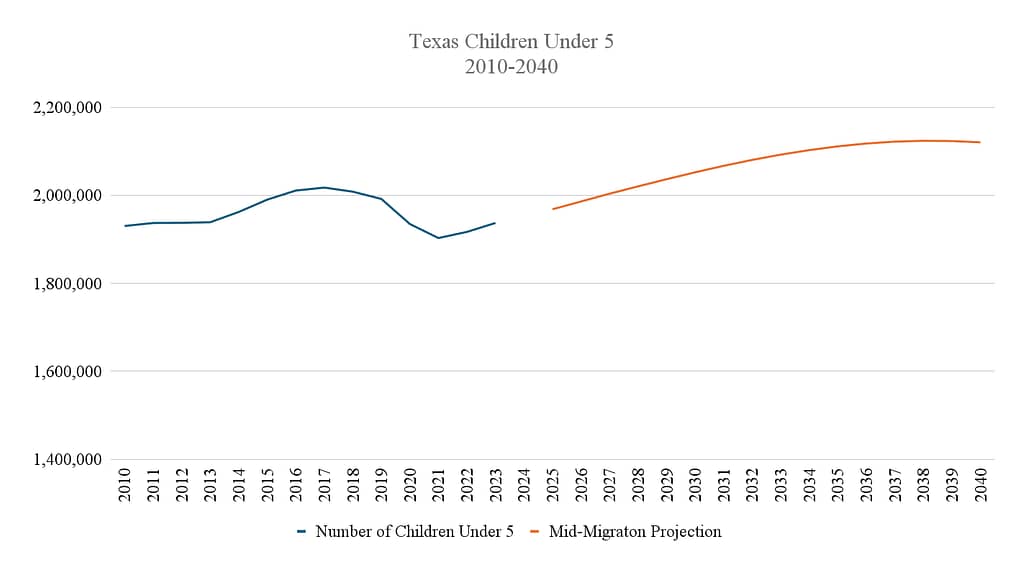Childcare supply and demand in Texas: What we know
In the last year, as many as 70,000 Americans of working age had to stay home from work each month due to childcare problems, according to the U.S. Bureau of Labor Statistics. In Texas, this challenge is especially pronounced for families with young children (under the age of five years old) as publicly funded K-12 schooling is not yet an option for them. Also, the availability of pre-K options for those children (both publicly-funded and tuition-based) is not consistent throughout the state.
This blog will explore what we know about the supply of and demand for childcare in Texas, as well as what we don’t know.
Demand for Childcare
As of 2023, there were an estimated 1.95 million children under the age of five in Texas, according to the Texas Demographic Center. This estimation represents a small decline from the 2017 peak of over 2 million children. Mid-migration projections from the Texas Demographic Center, however, predict that this population will steadily increase over the next 15 years, reaching 2.1 million in the next decade.
In the chart below, the blue line represents estimates of the number of children under the age of five in Texas between 2010 and 2023, while the orange line represents the projection of this population between the years of 2025 and 2040.

We know families have diverse needs and preferences when it comes to childcare, and not all the roughly 2 million children in Texas under the age of five require outside childcare at all or a seat in a center-based facility. But this number does give us an upper bound of the universe of children in the state who may require a seat in a center-based childcare facility.
Supply of Childcare Seats
As of 2024, the state had licensed nearly 8,400 facilities with the capacity to serve approximately 1 million children in the state through center-based day programs, according to the Texas Health and Human Services Commission’s Child Day Care Licensing Data Book.

Data Limitations
Licensed capacity shared by the state’s health and human services agency, however, does not reflect:
- Actual or staffed capacity. It is possible, for instance, for a facility to be licensed to serve 100 children, but only be staffed to serve a fraction of those students as there are strict caregiver-to-child ratios in facility settings.
- Capacity disaggregated by age group served by the available seat. Infant childcare, for example, requires different staffing levels and a different physical space than childcare for toddlers, and it’s unclear how many of the approximately 1 million licensed seats could be accessed by infants, toddlers or older children.
- Whether the licensed childcare seat is occupied or vacant. For families searching for a childcare seat in a licensed childcare center, total physical capacity is not useful in finding available seats.
Further Study
Texas 2036 is working hard to learn more about the state of our state’s childcare. Over the past year, we’ve been raising awareness of the need for increased and improved state data capacity and data sharing, so that our policymakers can make more informed decisions and investments responsive to the needs of Texans across the state.
Additionally, we’re planning a large-scale research project to learn more from Texans impacted most by the childcare system — parents, childcare providers and employers.
